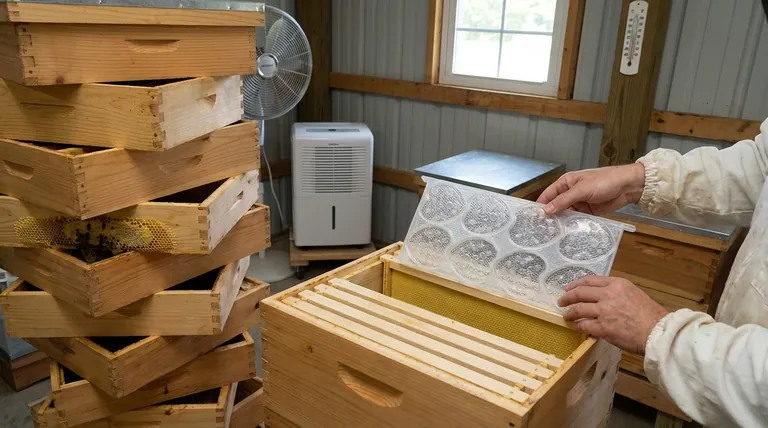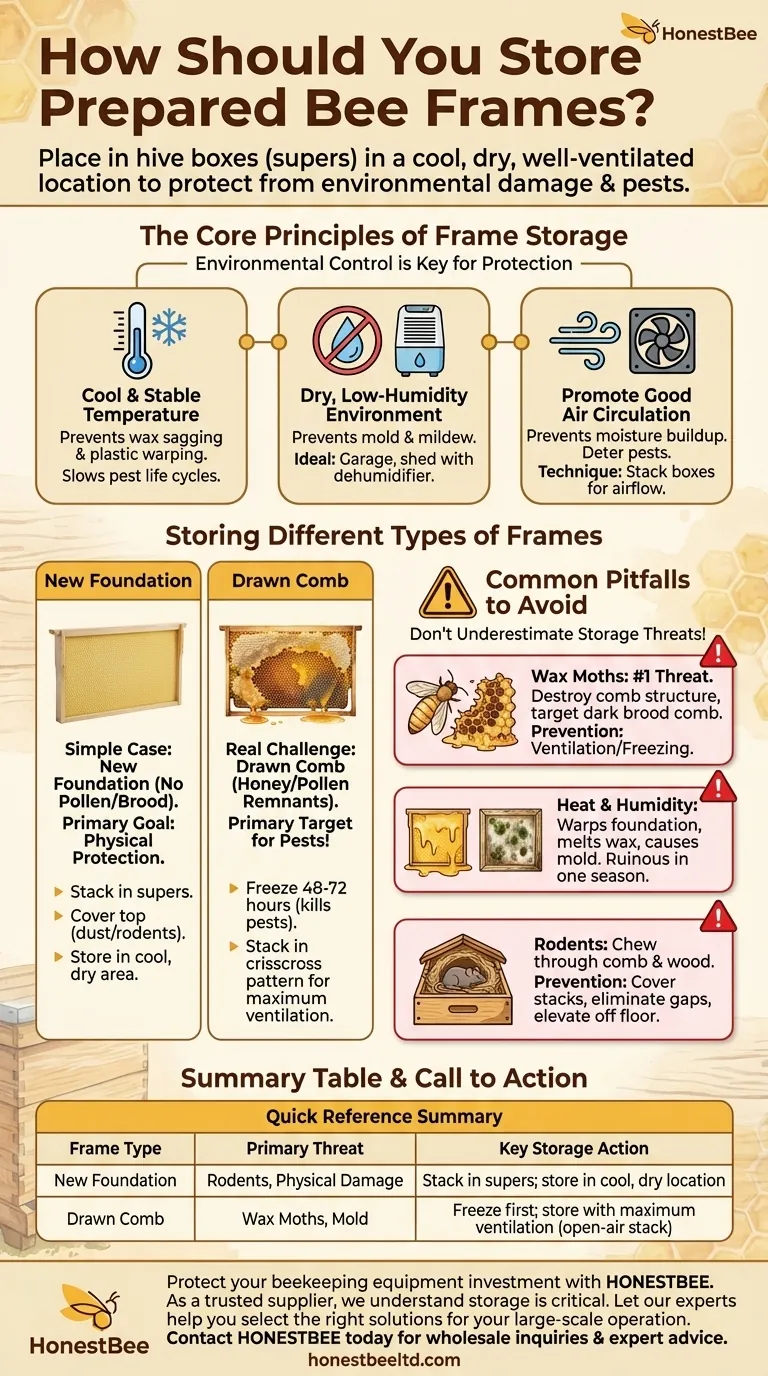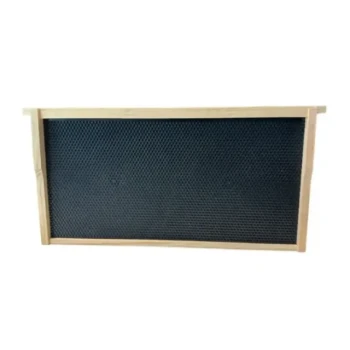To properly store prepared bee frames, you must place them inside hive boxes (supers) and keep them in a cool, dry, well-ventilated location. This protects the frames from the primary threats of environmental damage and pests, ensuring they are ready for immediate use when your hives need them.
The core challenge of frame storage is not just finding a space, but actively defending your equipment. Your strategy must be built around defeating the two biggest threats: pests like wax moths and environmental decay from heat and humidity.

The Core Principles of Frame Storage
Proper storage is an exercise in environmental control. Three factors are critical for protecting the wood, wax, and foundation of your frames.
Maintain a Cool, Stable Temperature
Excessive heat is a significant danger. It can cause wax foundation to sag and plastic foundation to warp, rendering the frame useless to the bees.
A cool environment also dramatically slows the life cycle of pests, particularly the destructive wax moth, giving you a passive layer of defense.
Ensure a Dry, Low-Humidity Environment
Humidity is the enemy of wood and a friend to mold. Frames stored in damp conditions will develop mildew, which can be harmful to bees and may cause them to reject the frame entirely.
A dry space, like a garage, shed, or basement with a dehumidifier, is ideal for preventing mold growth and keeping the woodenware sound.
Promote Good Air Circulation
Stagnant air contributes to moisture buildup and creates an inviting habitat for pests. Good ventilation helps keep the frames dry and makes the environment less hospitable for moths and other insects.
Stacking your boxes to allow for airflow is a simple but highly effective technique.
Storing Different Types of Prepared Frames
The right storage method depends entirely on what is on the frame. The risk profile for a frame with new foundation is vastly different from one with drawn-out honeycomb.
The Simple Case: Storing Frames with New Foundation
Frames that have only new, un-drawn foundation (either wax or plastic) are the easiest to store. They contain no pollen or brood remnants, making them unattractive to wax moths.
Your primary goal here is physical protection. Simply place the frames in a super, stack the supers, and cover the top to keep out dust and rodents. Store them in a location that meets the cool and dry criteria.
The Real Challenge: Storing Frames with Drawn Comb
Frames with drawn-out comb, especially "wet" supers just extracted or brood frames, are a prime target for pests. They contain honey remnants, pollen, and old cocoons that wax moths actively seek out.
For these frames, you must be more aggressive. The best non-chemical method is to provide maximum ventilation. Stack your supers in a crisscross pattern, creating a "chimney" of air that flows freely around every frame. This light, airy environment is a powerful deterrent to wax moths.
Alternatively, you can freeze frames with drawn comb for 48-72 hours. This kills any existing wax moth eggs or larvae before you place the frames into long-term ventilated storage.
Understanding the Common Pitfalls
Many beekeepers lose valuable equipment by underestimating common storage threats. Awareness is the first step toward prevention.
The Wax Moth Threat
Wax moths are the single greatest threat to stored comb. Their larvae tunnel through the wax, destroying the cell structure and leaving behind a mess of webbing and debris.
Frames with drawn comb, especially dark brood comb, are their primary target. Frames with only new foundation are generally safe.
The Dangers of Humidity and Heat
A hot attic or a damp basement can be disastrous. Heat will warp plastic foundation and melt wax, while humidity will inevitably lead to mold that can ruin comb and woodenware.
Always check your storage location's conditions, as a single season of improper storage can destroy an entire inventory of frames.
Forgetting Rodent Protection
Mice and other rodents love to build nests in the protected, enclosed space of a stored hive box. They will chew through comb and wood, causing significant physical damage.
Ensure your stacks of supers are covered and that there are no gaps for rodents to enter. Placing boxes on pallets off the floor can also help.
Making the Right Choice for Your Equipment
Your storage strategy should be tailored to the type of frames you have and the resources available to you.
- If your primary focus is storing new frames with fresh foundation: Your goal is simple physical protection. Stack them in supers in any cool, dry location safe from rodents.
- If your primary focus is storing frames with valuable drawn comb: You must prioritize aggressive pest and mold control through freezing, excellent ventilation (open-air stacking), and regular inspection.
Properly protecting your prepared frames during the off-season is a direct investment in the health and productivity of your colonies for the year to come.
Summary Table:
| Frame Type | Primary Threat | Key Storage Action |
|---|---|---|
| New Foundation | Rodents, Physical Damage | Stack in supers; store in cool, dry location |
| Drawn Comb | Wax Moths, Mold | Freeze first; store with maximum ventilation (open-air stack) |
Protect your beekeeping equipment investment with HONESTBEE.
As a trusted supplier of beekeeping supplies and equipment to commercial apiaries and distributors, we understand that proper storage is critical for maintaining your frames' integrity and your operation's efficiency. Our high-quality frames and hive boxes are built to last, but they need the right protection during the off-season.
Let our experts help you select the right equipment and storage solutions tailored for large-scale operations. Ensure your frames are ready for immediate, productive use season after season.
Contact HONESTBEE today for wholesale inquiries and expert advice on protecting your valuable beekeeping assets.
Visual Guide

Related Products
- Heart-Shaped Comb Honey Frame and Honeycomb Cassette
- Plastic Bee Frame Beekeeping Hive Frames for Wholesale
- Assembled Wooden Bee Frames with Beeswax Foundation Ready to Use by HONESTBEE
- Assembled Wooden Bee Frames with Plastic Foundation for Durability and Convenience by HONESTBEE
- Plastic Honey Comb Frames Cassette Box for Honey
People Also Ask
- What frame to use for honeycomb? Choose the Right System for Pure, Edible Comb
- How many jars of honey from one frame? Unlock the Secrets to Maximizing Your Harvest
- What is the bee hive shape called? The Hexagon's Role in Nature's Perfect Storage System
- How much honey can one medium frame yield? Unlock the Secrets to Maximizing Your Harvest
- What is the natural structure of comb drawn on wired frames? A Guide to Bee Instincts



















